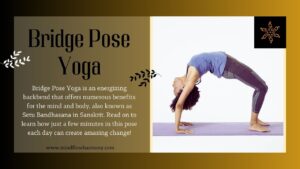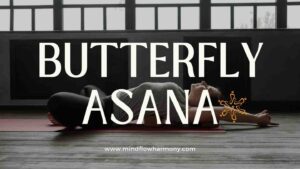Virabhadrasana, also known as the Warrior Pose, is a powerful and dynamic yoga posture that holds deep meaning and significance. In the ancient practice of yoga, the Virabhadrasana, or Warrior Pose, holds a special place. It not only strengthens the body but also symbolizes courage and determination.
In this blog post, we will explore the meaning, origin, mythological background, and the significance and symbolism of Virabhadrasana. Additionally, we will also discuss the numerous benefits, both physical and mental, that practicing Virabhadrasana can bring.
Table of Contents
What is Virabhadrasana?
Virabhadrasana is a yoga pose that goes beyond physical exercise. Its roots lie in ancient mythology and its symbolism embodies the warrior’s spirit within us. This pose is named after the legendary warrior Virabhadra, who is said to have been created by Lord Shiva himself.
The name “Virabhadrasana” comes from the ancient language called Sanskrit. It’s made up of two words, “Vira” and “Bhadra,” which mean “heroic” and “friend” when translated into English. This pose represents the strength, courage, and determination of a warrior. It is believed to have been developed by ancient yogis to embody the qualities necessary to overcome challenges and obstacles in life.
Also Read About Vipassana Yoga Retreat In Rishikesh
If you want to learn more about Virabhadrasana Yoga pose , then you have to join our Yoga Teacher Training Course in Rishikesh
- 100 Hour Yoga Teacher Training in Rishikesh
- 200 Hour Yoga Teacher Training in Rishikesh
- Yin Yoga Teacher Training in Rishikesh
Mythological Background of Virabhadrasana

According to Hindu mythology, Virabhadra was created by Lord Shiva in a fit of anger. When Lord Shiva’s beloved wife, Sati, immolated herself during a sacrificial ceremony, he was filled with immense grief and rage. In his fury, he tore out a lock of his hair and threw it to the ground, giving rise to Virabhadra. Virabhadra was a fierce warrior with a thousand heads, eyes, and arms. He was sent to avenge Sati’s death and destroy the sacrificial ceremony.
Significance and Symbolism of Virabhadrasana
Virabhadrasana is more than just a physical posture; it carries deep symbolism and significance. The pose represents the warrior’s spirit within us, reminding us of our inner strength and resilience. It teaches us to face challenges with courage, determination, and grace. By practicing Virabhadrasana, we cultivate qualities such as focus, stability, and inner power.
Also Read This Article: Yoga Nidra For Sleep And Anxiety
Benefits of Virabhadrasana
By practicing Virabhadrasana, we not only strengthen our physical body but also cultivate qualities such as courage, determination, and resilience.
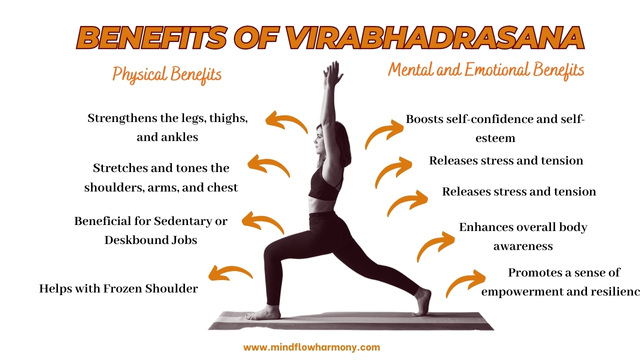
Let us explore some of them:
Physical Benefits:
- Strengthens the legs, thighs, and ankles: As you hold the pose, your arms and shoulders are engaged as you extend them overhead, building strength and stability in these areas. The deep lunge of the pose strengthens your thighs, particularly the quadriceps, and the muscles of your back are activated to support the upright posture.
- Stretches and tones the shoulders, arms, and chest: The pose requires your body to be in a stable position with your legs and arms stretched out in opposite directions. Regular practice of this pose helps to improve your balance by strengthening the muscles that support it and developing a sense of body awareness. Additionally, the sustained hold and engagement of various muscle groups in this pose can increase your stamina and endurance, improving your overall physical performance.
- Beneficial for Sedentary or Deskbound Jobs: Prolonged sitting can lead to poor posture, muscle imbalances, and weakened core muscles. By incorporating this pose into your routine, you engage your entire body and counteract the negative effects of prolonged sitting. It stretches the hip flexors, strengthens the back, and improves overall posture, helping to alleviate the discomfort associated with a sedentary lifestyle.
- Helps with Frozen Shoulders: Frozen shoulder or adhesive capsulitis, is a condition characterized by stiffness and pain in the shoulder joint. Virabhadrasana can help alleviate the symptoms of frozen shoulders by stretching and strengthening the muscles and ligaments in the shoulder area. The pose involves reaching and extending the arms, which can improve the range of motion in the shoulders and promote increased flexibility.
Also Read This Blog: How Much Do Yoga Instructors Make
Mental and Emotional Benefits:
- Boosts self-confidence and self-esteem: Virabhadrasana, or Warrior Pose, requires strength, balance, and focus. As practitioners improve in their ability to hold the pose and transition into it with ease, they develop a sense of accomplishment and confidence in their physical capabilities. This boost in self-confidence can also translate into other areas of life, helping individuals feel more empowered and capable.
- Releases stress and tension: Virabhadrasana can help release stress and tension that may have accumulated in the body and mind. The pose involves deep breathing and stretching, which can help relax the muscles and release physical and mental stress. By focusing on the present moment and the sensations in your body, you can let go of worries and tensions, promoting a sense of calm and relaxation.
- Cultivates mental focus and clarity: Warrior Pose requires concentration and focus to hold the pose properly and maintain balance. As the mind becomes absorbed in the present moment, distractions and scattered thoughts can fade away, allowing for greater mental clarity and focus. This can help improve overall cognitive function and increase productivity and efficiency in daily life.
- Enhances overall body awareness: Virabhadrasana helps cultivate a deeper sense of body awareness. As you get into the position and keep it, you become more aware of how your body lines up, the feelings in your muscles, and you’re breathing. This heightened body awareness can extend beyond the yoga practice, allowing you to notice and address physical and emotional imbalances in your daily life.
- Promotes a sense of empowerment and resilience: This pose symbolizes a warrior, embodying qualities such as strength, courage, and determination. As you practice the pose, you can tap into these qualities within yourself, fostering a sense of personal power and resilience.
Understanding the Variations of Virabhadrasana
Each variation offers its own unique benefits and challenges, allowing practitioners to explore different aspects of their strength, balance, and flexibility.
Also Read This Blog What is Ashtanga Yoga and Explain in Detail?
Virabhadrasana I (Warrior Pose I)
Virabhadrasana I, also known as Warrior I, is the foundational variation of the Warrior Pose.
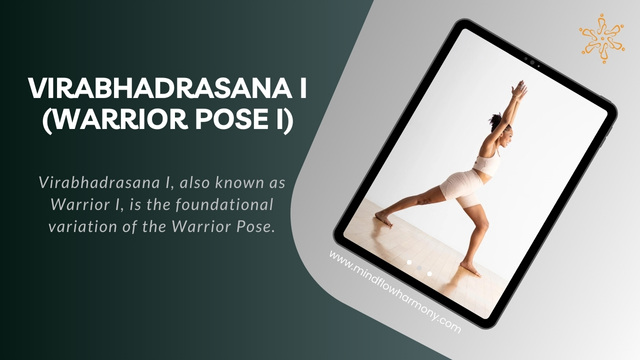
How to practice Virabhadrasana I (Warrior Pose I)
- Start by standing at the top of your mat with your feet hip-width apart.
- Move the left foot backwards, maintaining an angle of 45 degrees.
- Bend your right knee, ensuring it is directly above your ankle.
- Inhale with arms up, palms facing each other.
- Sink your hips down and lift your chest, gazing up toward your hands.
To deepen your Warrior I, you can try lifting your back heel off the ground, coming onto the ball of your foot. As a result, the muscles in the back leg work harder, making the stretch in the hip flexors and quadriceps stronger. Remember to keep your core engaged and your gaze steady to maintain stability and balance.
Benefits Of Virabhadrasana I (Warrior Pose I)
This variation strengthens the legs, opens the hips, and stretches the chest and shoulders.
Virabhadrasana II (Warrior Pose II)
Virabhadrasana II, or Warrior II, builds upon the foundation of Warrior I.
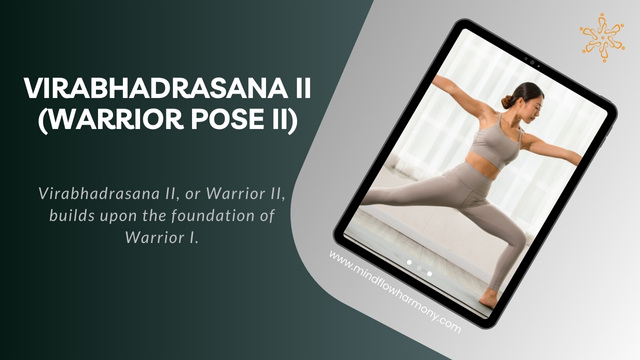
How to practice Virabhadrasana II (Warrior Pose II)
- From the starting position, take a big step back with your left foot, turning it out at a 90-degree angle.
- Extend your arms out to the sides, parallel to the floor, with your palms facing down.
- Bend your right knee, keeping it directly above your right ankle. Ensure that your knee is not extending beyond your ankle.
- Keep your gaze focused over your right fingertips, allowing your body to open up towards the side.
- Engage your core and maintain a strong connection with the ground through your feet.
- Hold this pose for several breaths, feeling the strength and stability in your legs and the open expansion of your chest.
- To release, straighten your right leg, lower your arms, and step your left foot back to meet your right.
- Restart at the start point and repeat the same steps on the opposite side.
Also Read This: Discover the Benefits of Kundalini Yoga
Benefits of Virabhadrasana II (Warrior Pose II)
Virabhadrasana II, also known as Warrior II Pose, is a foundational yoga asana that holds significant importance in the practice of yoga. This powerful posture not only strengthens the body but also cultivates focus, stability, and mindfulness.
- Physical Strength and Stability: One of the key benefits of practicing Virabhadrasana II is its ability to enhance physical strength and stability. This posture primarily targets the legs, hips, and core muscles, effectively toning and strengthening them. Regular practice of Warrior II can help build lean muscle mass, improve balance, and increase overall physical endurance.
- Improved Flexibility: Alongside building strength, Virabhadrasana II also promotes flexibility in the body. The extended stance and deep lunge of this pose stretch and open up the hips, groin, and inner thighs. With consistent practice, individuals can witness improved flexibility in these areas, leading to a greater range of motion and ease in daily activities.
- Enhanced Focus and Concentration: The practice of Virabhadrasana II is known to cultivate mental focus and concentration. As the practitioner holds the powerful stance, they are required to remain fully present in the moment, disregarding any distractions. This meditative aspect of the pose helps calm the mind, reduce stress, and improve mental clarity.
- Increased Awareness of the Body: Virabhadrasana II offers practitioners the opportunity to develop a deeper connection with their physical body. By encouraging proper alignment, this pose promotes body awareness and proprioception. Practicing regularly can help individuals gain a better understanding of their body’s strengths, limitations, and areas that require attention.
- Stimulates Blood Circulation: The dynamic nature of Warrior II stimulates blood circulation throughout the body. The extended arms and open chest in this pose encourage deep breathing, which, in turn, increases oxygen intake and improves blood flow. This enhanced circulation promotes better cardiovascular health and overall well-being.
- Empowerment and Confidence: Virabhadrasana II is a pose that symbolizes strength, power, and determination. The warrior-like stance and gaze foster a sense of empowerment and confidence within the practitioner. Regularly practicing this pose can help individuals feel more self-assured, both on and off the yoga mat.
Virabhadrasana III (Warrior Pose III)
Virabhadrasana III, also known as Warrior III, takes the pose to a whole new level by challenging your balance and core strength.
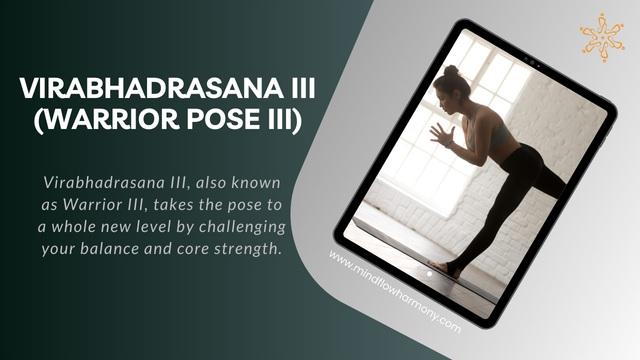
How to practice Virabhadrasana III (Warrior Pose III)
- Begin in Tadasana, or Mountain Pose.
- Shift your weight onto your right foot and hinge forward at the hips, extending your left leg behind you.
- Keep your arms alongside your body or extend them forward, parallel to the ground.
- Find a focal point to help you maintain balance.
To deepen your Warrior Pose III, try flexing your back foot and pressing through the heel. This will activate the muscles in your leg and create a strong and stable foundation. Keep your gaze focused on your chosen point to help steady your mind and maintain balance.
With practice, you will feel a sense of lightness and empowerment as you soar like a warrior through the air.
Also Read This Blog: Elevate Your Career: The Ultimate Guide to Yoga Teacher Training After 12th
Benefits Of Virabhadrasana III (Warrior Pose III)
Warrior Pose III improves balance, strengthens the legs and core, and tones the entire body.
Reverse Warrior (Viparita Virabhadrasana)
Reverse Warrior, or Viparita Virabhadrasana, is a variation that adds a graceful and flowing element to the Warrior sequence.
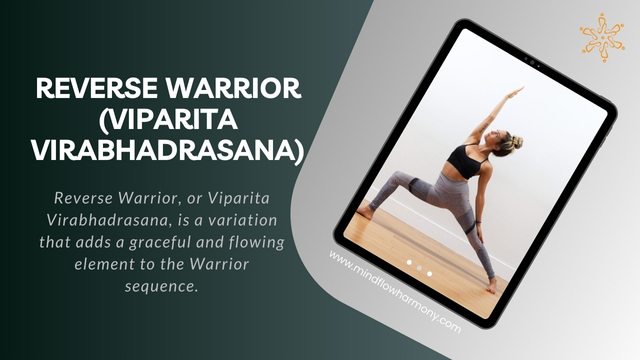
How to practice Reverse Warrior (Viparita Virabhadrasana)
- From Warrior II, flip your front palm up toward the sky and reach your back hand down your back leg, sliding it gently toward your ankle.
- Lift your front arm up and back, gazing toward the sky or your fingertips.
- Reverse Warrior stretches the side body, opens the chest and shoulders, and strengthens the legs and core.
- As you move into Reverse Warrior, focus on lengthening through both sides of your body.
- Keep your front knee bent and aligned with your ankle to protect your knee joint.
- Feel the expansion in your chest and the stretch along your side as you gracefully flow through this variation.
Extended Side Angle (Utthita Parsvakonasana)
Extended Side Angle, or Utthita Parsvakonasana, is another variation that adds depth and challenge to the Warrior sequence.
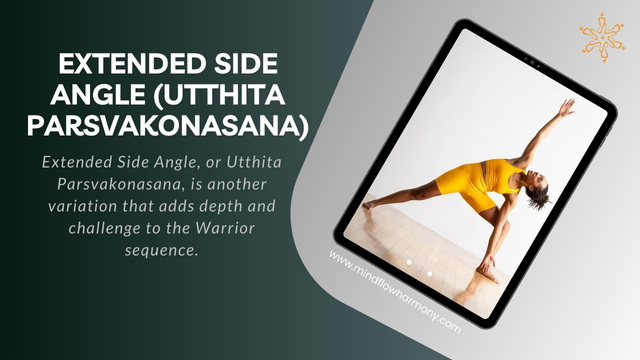
How to practice Extended Side Angle (Utthita Parsvakonasana)
- From Warrior II, lower your front arm to your front thigh or the ground, reaching your top arm overhead, creating a diagonal line from your back foot to your fingertips.
- Extend through your side body and keep your gaze upward or toward your top hand.
- Extended Side Angle strengthens the legs, stretches the hips and side body, and improves balance and concentration.
- As you practice Extended Side Angle, focus on maintaining a strong and stable foundation through your legs.
- Engage your core to support your spine and open your chest, allowing for deep breaths.
- Embrace the sensation of strength and expansion as you create space in your body and mind.
Bound Warrior (Baddha Virabhadrasana)
Bound Warrior, or Baddha Virabhadrasana, is an advanced variation that challenges your flexibility and balance.
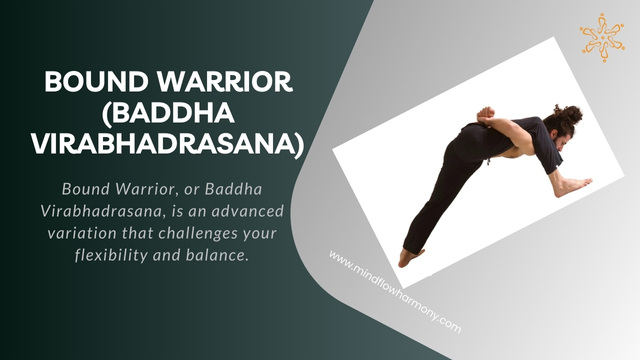
- From Warrior II, reach your front arm behind your back and clasp your hands together, interlacing your fingers.
- If you can’t reach your hands, you can use a strap or towel to connect them.
- Keep your back arm active, reaching it toward the sky.
As you practice Bound Warrior, focus on keeping your breath steady and your gaze soft. Engage your core and maintain a strong foundation through your legs. Be gentle with yourself and honor your body’s limits, only going as far as feels comfortable and safe. With consistent practice, you will gradually increase your flexibility and find a sense of freedom and release in this challenging variation.
Benefits Of Bound Warrior (Baddha Virabhadrasana)
Bound Warrior deepens the stretch in the shoulders, chest, and quadriceps, while also strengthening the legs and core.
Also Read: Best Yoga Teacher Training For Beginners In India
Precautions and Modifications for Virabhadrasana
While Virabhadrasana offers numerous benefits, it’s important to practice with awareness and listen to your body. Here are some precautions and modifications to keep in mind:
- Knee Alignment: Ensure that your knee is aligned with your ankle in all variations of Virabhadrasana to protect your knee joint. Avoid letting your knee extend beyond your ankle, as this can strain the knee.
- Hip Flexibility: If you have tight hips, consider placing a block or folded blanket under your back heel in Warrior I and Warrior II. This will provide more stability and allow you to focus on opening your hips gradually.
- Shoulder and Chest Mobility: If you have limited shoulder or chest mobility, you can modify the arm positions in the variations that involve reaching your arms overhead or behind your back. Use a strap or towel to bridge the gap and gradually work towards a deeper range of motion.
- Balance and Stability: If you struggle with balance, practice near a wall or use a chair for support. You can also focus on fixing your gaze on a stationary point to help steady your mind and body.
- Listening to Your Body: Always listen to your body and honor its limits. If any pose causes pain or discomfort, ease out of it or modify it to suit your needs. It’s important to practice with mindfulness and respect for your body’s unique abilities.
Tips for Mastering Virabhadrasana
Mastering the variations of Virabhadrasana takes time, patience, and consistent practice. Here are some tips to help you deepen your understanding and experience of these powerful poses:
- Focus on Alignment: Align your knees, hips, and shoulders to maintain stability and protect your joints.
- Breathe Mindfully: Allow your breath to guide your movements and help you find a sense of ease and flow.
- Practice Regularly: Make sure to dedicate consistent time for your practice, even if it’s only a few minutes every day. Slowly increase how long and how hard you practice as you become stronger and more confident.
- Explore Modifications: Don’t be afraid to modify the poses to suit your body’s needs. Modify the arm positions or the depth of the poses as you gradually build flexibility and strength.
- Stay Present and Patient: Remember that yoga is a journey, and progress comes with time and dedication. Avoid comparing yourself to. Stay present in each moment, honoring where you are on your unique path.
- Seek Guidance: If you’re new to yoga or want to deepen your practice, consider seeking guidance from an experienced yoga teacher.
Conclusion
Practicing Virabhadrasana allows us to tap into our own inner warrior, cultivating these qualities within ourselves. It is a reminder of our own power and the ability to face challenges head-on with grace and resilience.
Also Read This Article: Best Yoga School in Rishikesh: Perfect Place for Yoga in Rishikesh
Frequently Asked Questions about Virabhadrasana
Q. What Does Virabhadrasana Do?
Ans: Virabhadrasana enhances physical strength and flexibility while promoting balance and stability in the body.
Q. What is the Myth of Virabhadrasana?
Ans: According to the myth, Virabhadra was created by Lord Shiva when he became furious upon learning about the death of his wife, Sati. Virabhadra was then sent to Earth to avenge Sati’s death. His anger and determination are reflected in the warrior pose.
Q. Why is Virabhadrasana II Important?
Ans: Among the different variations of the warrior pose, Virabhadrasana II is particularly important. It is a standing posture, where the feet are spread wide apart, and the arms are extended out to the sides. This pose helps to increase stamina, build strength, and improve balance.
Q. What are the Benefits of Virabhadrasana Procedure?
Ans: The benefits of the Virabhadrasana procedure, also known as Warrior pose, include improved strength and flexibility in the legs, hips, and shoulders, increased stamina, improved focus and mental clarity, better balance and stability, and it also stretches and strengthens the core, arms, and back muscles.
Additionally, this pose can help with anxiety and stress relief, and it may also improve digestion and stimulate the abdominal organs.
Q. Is Virabhadrasana Good for the Heart?
Ans: Virabhadrasana is a good yoga pose for the heart as it increases blood circulation and heart rate, bringing oxygen and nutrients to the heart muscle. It also helps to strengthen the legs and core muscles, which can improve cardiovascular health.
Q. Who Should Avoid Virabhadrasana?
Ans: Individuals with certain heart conditions, such as high blood pressure or heart disease, should avoid or modify Virabhadrasana.
If you have any specific health concerns or conditions consult with doctor before adding any yoga exercise to your schedule.
Q. How to Practice Virabhadrasana?
Ans: To practice Virabhadrasana, follow the steps below-
· Begin in a standing position with the feet wide apart.
· Turn the right foot out to a 90-degree angle and the left foot slightly inward.
· Bend the right knee until it is directly above the ankle, keeping the left leg straight.
· Extend the arms out to the sides at shoulder height, keeping the shoulders relaxed.
· Hold the pose for several breaths, then repeat on the other side.
Q. What are the Steps of Virabhadrasana?
Ans: The steps of Virabhadrasana include standing with your feet wide apart, turning one foot out and bending the other leg, raising your arms parallel to the ground, and holding the pose while focusing on your breathing and alignment.


